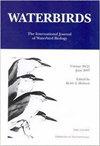Vocal Activity of Little Bittern (Ixobrychus m. minutus) during the Breeding Season
IF 0.6
4区 生物学
Q3 ORNITHOLOGY
引用次数: 1
Abstract
Abstract. Heron vocalization and its behavioral functions are one of the least researched aspects of heron biology. The main aim of this study was to investigate the patterns of seasonal and daily vocal output of male Little Bittern (Ixobrychus m. minutus; n = 8) during the breeding season (May–August). The advertising call started on 10th May, and finished on 28th July. The first peak of calling activity occurred between 21st May and 1st June, and the second one was between 14th June and 7th July. The daily vocal activity fluctuated and depended on the time of day. The males were most active between 0300–0900 hours and 1600–2200 hours, with the highest peaks in vocal output occurring before sunrise and before sunset. Higher vocal activity was observed in the evening compared to the morning hours. Moreover, the vocal activity of males was not related to air temperature.小麻鸦(Ixobrychus m. minutus)在繁殖季节的发声活动
摘要苍鹭的发声及其行为功能是苍鹭生物学中研究最少的一个方面。本研究的主要目的是研究雄性小卤(Ixobrychus m. minutus)的季节性和每日声音输出模式;繁殖期(5 - 8月)n = 8)。广告从5月10日开始,7月28日结束。第一个呼叫高峰发生在5月21日至6月1日,第二个呼叫高峰发生在6月14日至7月7日。每天的声音活动是波动的,并取决于一天中的时间。雄性在0300-0900小时和1600-2200小时之间最活跃,日出前和日落前的声音输出达到最高峰。与早晨相比,晚上观察到更高的声音活动。此外,雄性的发声活动与气温无关。
本文章由计算机程序翻译,如有差异,请以英文原文为准。
求助全文
约1分钟内获得全文
求助全文
来源期刊

Waterbirds
生物-鸟类学
CiteScore
1.30
自引率
0.00%
发文量
0
审稿时长
6-12 weeks
期刊介绍:
Waterbirds is an international scientific journal of the Waterbird Society. The journal is published four times a year (March, June, September and December) and specializes in the biology, abundance, ecology, management and conservation of all waterbird species living in marine, estuarine and freshwater habitats. Waterbirds welcomes submission of scientific articles and notes containing the results of original studies worldwide, unsolicited critical commentary and reviews of appropriate topics.
 求助内容:
求助内容: 应助结果提醒方式:
应助结果提醒方式:


